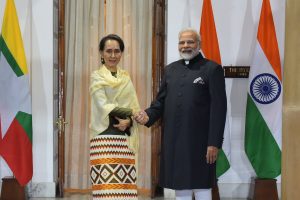Last week, India’s Chief of Naval Staff Admiral Karambir Singh visited Myanmar in a trip lasting from February 17 to 20. The trip, which came just weeks after Chinese President Xi Jinping’s trip to the country, spotlighted the tussle between China and India for influence in the Southeast Asian state.
Myanmar has long factored into India’s strategic calculations: Delhi considers relations with Myanmar to be very important, particularly in the context of evolving Indo-Pacific strategic dynamics, and Myanmar is also a key link in furthering India’s ‘Act East’ Policy. For China, which has a bigger political and economic footprint in Myanmar, its inroads into Myanmar have geostrategic implications because it gives Beijing proximity to the Bay of Bengal and the Andaman Sea, maritime space that is crucial to Indian security.
But India nonetheless continues to compete and consolidate its ties with Myanmar for its own interests. As the statement from the Indian Ministry of Defense said, Admiral Singh’s “visit is intended to consolidate and enhance the bilateral maritime relations between India and Myanmar.”
That was seen in aspects of the visit itself as well. During his visit, Admiral Singh called on a range of top officials, including Admiral Tin Aung San, commander in chief of the Myanmar Navy, Senior General Min Aung Hlaing, the Commander in Chief of Defense Services, and other senior government officials, including Aung San Suu Kyi, the State Counselor and Minister of Foreign Affairs.
During his meeting with Admiral Tin Aung San, Adm. Singh offered increased training assistance for the Myanmar Navy. The Indian Navy chief is reported to have briefed the officials on the state of cooperation between the two navies. The navy chief also held interactions with trainees of the National Defense College in Naypyidaw and visited the Naval Dockyard and Training Command of the Myanmar Navy in Yangon.
These gains were notable but not necessarily surprising. The defense aspect of the relationship has been built on by both sides over the past few years, including not just regular exercises, visits, and training, but also defense equipment, with a case in point being when India handed over a diesel-electric Kilo-class submarine, INS Sindhuvir, which India refurbished after procuring from Russia in the 1980s.
Furthermore, the challenge for India in competing with China in Myanmar lies less in the naval domain and more in other aspects. In the economic domain, for instance, India’s lack of capacity to reach out and address many of Myanmar’s requirements is stark, especially when pitted against China and its Belt and Road initiative. Key projects, such as the trilateral India-Myanmar-Thailand highway project and the multi-modal Kaladhan Transit Transport project, are behind schedule.
Myanmar’s importance to India cannot emphasized enough. Given India’s push for the Bay of Bengal Initiative for Multi-Sectoral Technical and Economic Cooperation (BIMSTEC), Myanmar remains a critical pillar for closer engagement with the southeast Asian region. But New Delhi is still to resolve its problem with delivering on its promises.

































